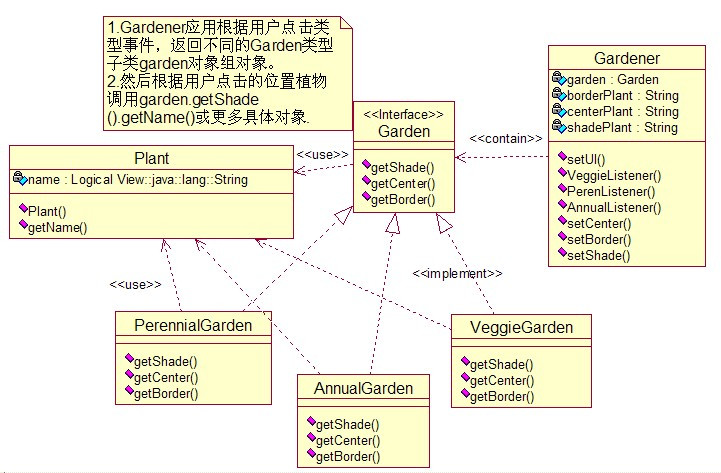Abstract Factory抽象工厂模式-java设计模式2一、概念:Abstract Factory是比Factorymethod更加抽象的一种模
Abstract Factory抽象工厂模式-java设计模式2
一、概念:Abstract Factory是比Factorymethod更加抽象的一种模式,不是在factory也不是在子类中决定返回的子类,而是将这种判断交给的应用类。1.判断在应用类,返回创建类的子类对象组对象。2.用对象组对象可以factory基类中声明的方法返回模型对象,模型对象可以返回不同的具体对象。
二、实例:创建一个园林的设计方案小程序,可以根据种植时间长短返回不同的种植方案,种植方案下可以返回不同的具体植物类型,程序的UML类图:

三、源代码解析:
3.1创建类的Garden接口:
package create.factory.abstractfactory;
public interface Garden {
??? public Plant getShade();
??? public Plant getCenter();
??? public Plant getBorder();
}
只是声明了相关的方法。
3.2创建接口的多个子类:
package create.factory.abstractfactory;
public class VeggieGarden implements Garden {
??? public Plant getShade() {
??????? return new Plant("Broccoli");
??? }
??? public Plant getCenter() {
??????? return new Plant("Corn");
??? }
??? public Plant getBorder() {
??????? return new Plant("Peas");
??? }
}
只是实现了接口中定义的方法,返回实体模型类的不同对象(将对象实体创建)。其它两个类类似。
3.3对象实体模型类:
package create.factory.abstractfactory;
public class Plant {
??? private String name;
??? public Plant(String pname) {
??????? name = pname;???? //save name
??? }???????
??? public String getName() {
??????? return name;
??? }
??? }
3.4应用程序框架类:
package create.factory.abstractfactory;
import java.awt.*;
import java.awt.event.*;
//illustrates use of Abstract Factory pattern
public class Gardener extends Frame
implements ActionListener {
??? private Checkbox Veggie, Annual, Peren; //单选框对象
??? private Button Center, Border, Shade, Quit;
??? private Garden garden = null; //使用了创建接口引用对象。
??? private GardenPanel gardenPlot; //后面定义的显示具体对象的类。
??? private String borderPlant = "", centerPlant = "", shadePlant = ""; //对应于具体对象
?public Gardener() {
??????? super("Garden planner"); //super时就是调用父类构造函数,此为Frame(String title);
??????? setGUI();
??? }
??? //----------------------------------
??? private void setGUI() {
??????? setBackground(Color.lightGray); //getContentPane.setBackground(...)也就是Frame类设置背景色
??????? setLayout(new GridLayout(1,2));//使用了GridLayout,将Frame设置为(1,2)网格。
??????? Panel left = new Panel();
??????? add(left);?????????????????????????? //Frame.add(left);
??????? Panel right= new Panel();
??????? add(right);?????????????????????????????? //Frame.add(right);
?//create label and 3 radio buttons on left side
??????? left.setLayout(new GridLayout(4, 1));? //再将 Panel类型的left设置(4,1)网格。
??????? left.add(new Label("Garden type"));//在网格中默认为从上到下,从左到右添加。
??????? CheckboxGroup grp= new CheckboxGroup();
??????? Veggie = new Checkbox("Vegetable", grp, false);
??????? //设置Checkbox构造方法用CheckboxGroup初始化属性,所以为聚合关系。
??????? Annual = new Checkbox("Annual", grp, false);
??????? Peren = new Checkbox("Perennial", grp, false);
??????? left.add(Veggie); //通过聚合关系后拥有了特性,在用left.add Checkbox对象而不是CheckboxGroup对象。
??????? left.add(Annual);
??????? left.add(Peren);
??????? Veggie.addItemListener(new VeggieListener()); //为其添加监听器,从而决定返回那个对象组。
??????? Peren.addItemListener(new PerenListener());
??????? Annual.addItemListener(new AnnualListener());
??????? //now create right side
??????? right.setLayout(new GridLayout(2,1)); //再将 Panel类型的right设置(2,1)网格。
??????? gardenPlot = new GardenPanel(); //后面显示具体对象的类,为其创建对象。
??????? gardenPlot.setBackground(Color.white);
??????? Panel botRight = new Panel();
??????? right.add(gardenPlot);//将显示具体对象类添加到right网格的第一行
??????? right.add(botRight); //将Button Panel面板放置到第二行
??????? Center = new Button("Central");
??????? Border =? new Button("Border");
??????? Shade = new Button("Shade");
??????? Quit = new Button("Quit");
??????? botRight.add(Center); //连续的添加button及它的监听器。
??????? Center.addActionListener(this);
??????? botRight.add(Border);
??????? Border.addActionListener(this);
??????? botRight.add(Shade);
??????? Shade.addActionListener(this);
??????? botRight.add(Quit);
??????? Quit.addActionListener(this);
??????? setBounds(200,200, 400,300);
??????? setVisible(true);
??? }
??? //----------------------------------
??? public void actionPerformed(ActionEvent e) {? //button类共同的默认监听器实现方法actionPerformed(),此处没有定义监听器类。
??????? Object obj = e.getSource();
??????? if (obj == Center)
??????????? setCenter();
??????? if (obj == Border)
??????????? setBorder();
??????? if (obj == Shade)
??????????? setShade();
??????? if (obj == Quit)
??????????? System.exit(0);
??? }
??? //----------------------------------
??? private void setCenter() {//通过得到的返回子类对象组garden,调用getCenter返回Plant类型,getName返回String类型。
??????? if (garden != null) centerPlant = garden.getCenter().getName();
??????? gardenPlot.repaint();
??? }
??? private void setBorder() {
??????? if (garden != null) borderPlant = garden.getBorder().getName();
??????? gardenPlot.repaint();
??? }
??? private void setShade() {
??????? if (garden != null) shadePlant = garden.getShade().getName();
??????? gardenPlot.repaint();
??? }
??? private void clearPlants() {??????????? //当用户切换到其他的对象组时,将具体对象清除,然后repaint 会调用paint方法生效。
??????? shadePlant=""; centerPlant=""; borderPlant = "";
??????? gardenPlot.repaint();
??? }
??? //----------------------------------
??? static public void main(String argv[]) {
??????? new Gardener();
??? }
//--------------------------------
??? class GardenPanel extends Panel {
??????? public void paint (Graphics g) {
??????????? Dimension sz=getSize();
??????????? g.setColor(Color.lightGray);
??????????? g.fillArc( 0, 0, 80, 80,0, 360);
??????????? g.setColor(Color.black);
??????????? g.drawRect(0,0, sz.width-1, sz.height-1);
??????????? g.drawString(centerPlant, 100, 50);
??????????? g.drawString( borderPlant, 75, 120);
??????????? g.drawString(shadePlant, 10, 40);
??????? }
??? }
??? //-----------------------------
??? class VeggieListener implements ItemListener {
??????? public void itemStateChanged(ItemEvent e) {
/*对于Checkbox类型,由关联关系,ItemListener是将ItemEvent消息标识和checkbox标识,传递给特定的ItemStateChange方法来处理的。*/
??????????? garden = new VeggieGarden();
??????????? clearPlants();
??????? }
??? }
??? //-----------------------------
??? class PerenListener implements ItemListener {
??????? public void itemStateChanged(ItemEvent e) {
??????????? garden = new PerennialGarden();
??????????? clearPlants();
??????? }
??? }
??? //-----------------------------
??? class AnnualListener implements ItemListener {
??????? public void itemStateChanged(ItemEvent e) {
??????????? garden = new AnnualGarden();
??????????? clearPlants();
??????? }
??? }
}???? //end of Gardener class
四、结论:1.抽象工厂模式的一个主要目的是把所生成的具体类相分离,这些类的实际名称被隐藏在工厂中,客户不必了解。2.修改类时,可以自由地修改或者交换这些产品类系列,不会导致系列间的相互影响。3.添加类时,不可避免的会有额外不相同方法的类;此时:(1)可以在基类中定义所有的方法(即使他们不一定有实际的功能)。(2)派生一个新的基类,使之包含所需的全部方法,然后为所有的园林类型派生相应的子类。
